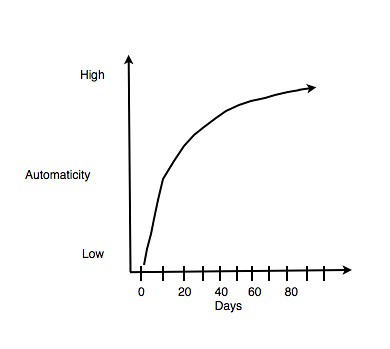Habit is all about the relationship between repetition and automaticity. If a person starts a new behaviour and repeats it every day how long does it take for that behaviour to become automatic (habitual).
A person smokes marijuana everyday for a year. He then stops smoking marijuana = the new behaviour. How long will it take for the non smoking to become habitual or automatic. The answer is there is not a linear relationship between repetition and automaticity. Instead the relationship results in an asymptotic curve as shown here.
The early days of the repetitions of the new behaviour (not smoking marijuana) result in a quick increase in automaticity. After a time this slows and there is a plateau effect in the automaticity where more repetitions result in little increase in the automaticity.
A behaviour is generally regarded as fully habitual when a person reaches 95% of asymptote. A 100% is when further repetitions result in no more increase in automaticity and there is a complete plateau. Research suggests that the time to reach 95% of asymptote takes 66 days. There can however be considerable variation with a range from 18 to 254 days.
Hence it can be said that for one to become a fully habitual non marijuana smoker will take 66 days. At that time the fully formed habit assists the person not to smoke marijuana again.
Habit - friend or foe?
The cigarette smoker who has smoked for sometime finds it hard to stop for a number of reasons, one being that it is simply a habit. In this case the smoker can see the habitual quality of smoking as a hinderance to stopping. The habit is a foe.
If the person should stop smoking for 66 days then they have broken one habit but started another. They have broken the habit of smoking but picked up the habit of being a non smoker. This maens for the person to again become a habitual smoker they have to break the habit of being a non smoker. This is not an easy thing for people to do as most of us know. In this case the habit is a freind.
Ego syntonic and ego dystonic
Something is said to be ego dystonic when the person perceives it to be foreign to them, outside them or not belonging to them. Something is ego syntonic when the person sees it to be part of them, belonging to them or forms part of who they are
These are two important concepts in psychotherapy. Is the problem ego syntonic or ego dystonic for the client?
A client may present with agoraphobia or perhaps insomnia. The therapist needs to ascertain in his own mind does the client see self as
1. A person who can experience agoraphobia, (ego dystonic)
2. An agoraphobic (ego syntonic)
Does the client experience self as
1. A person who can suffer insomnia, (ego dystonic)
2. An insomniac (ego syntonic)
Unfortunately in most circumstances by the time the client gets to therapy the problem has become ego syntonic.
A person sleeps normally and then for some reasons starts to sleep poorly. Initially this will feel abnormal to the person and the problem is seen as ego dystonic. They perceive self as someone who sometimes does not sleep well but not as an insomniac.
Over time if the insomnia continues the person’s view of it changes. It becomes something they expect to happen because it has happened many times before. They tend to start to view it as part of who they are - an insomniac. When this change occurs the problem then becomes ego syntonic. The insomnia is perceived by the person as part of who they are and how they live.
The shift from ego dystonic to ego syntonic can be seen to have at least three aspects.
1. It becomes habitual
If a person has slept poorly most nights for the past year then the insomnia is partly a habitual way of being for the person regardless of any other causes for it.
2. It becomes part of the persons life style
As it becomes a habitual pattern of being the person will adjust the practicalities of their life style to fit for it. They will tend to do the same things like get up and do such and such and then go back to bed and then wake up again. They develop a routine at night time that incorporates the insomia.
3. It becomes part of the person’s self perception or part of their identity.
Finally it becomes how the person sees self and a sense of who they are as a person. I am an insomniac is part of the person’s sense of identity.
If a person has slept poorly three nights in the last four months then it wont be habitual, they have no routine when being awake and it is not part of who they see they are.
How long does it take a problem to shift from being ego dystonic to ego syntonic?
In trauma debriefing research indicates that therapy should start within 6 weeks of the trauma. The earlier you start the better. After 6 weeks it is harder to treat the problem (PTSD) as it has become ego syntonic.
As mentioned above research on the formation of new habits indicates that it takes 66 days for a new habit to fully form. After that the person will behave habitually in the new way. Of course this varies on how often the new behaviour occurs and if there are any relapses along the way.
This suggests that it will take about 1.5 to 2 months for a problem to move from being ego dystonic to ego syntonic if the new problem occurs regularly.
If it is ego syntonic then not only does one have to treat the insomnia, but also the habit of not sleeping and the routine involved, along with the self perception of the client as an insomniac.
Graffiti





No comments:
Post a Comment